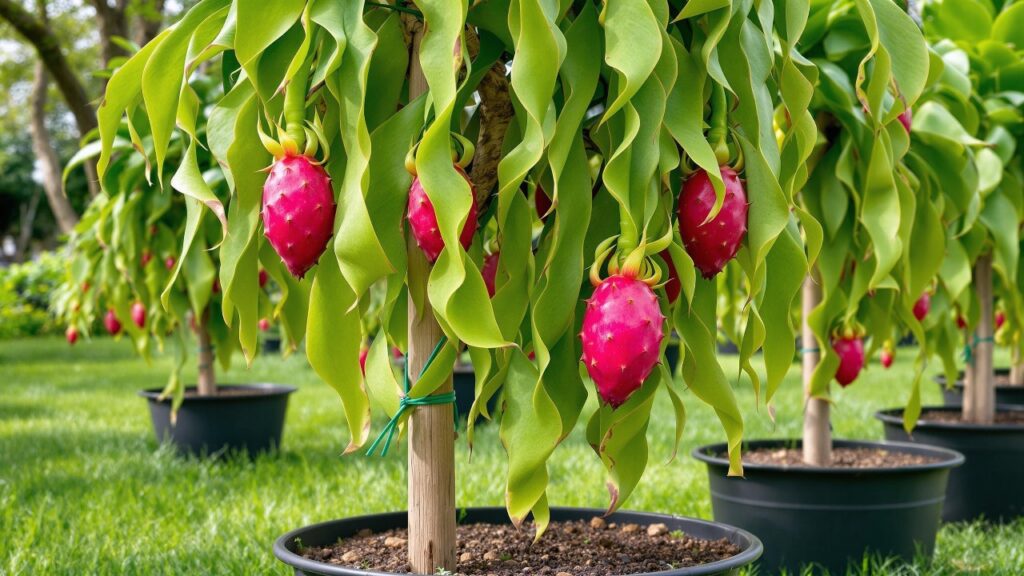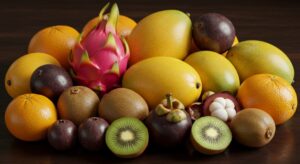Introduction
Imagine walking into your backyard or balcony and picking fresh passionfruit, mangoes, or even dragonfruit. Sounds dreamy, right? Growing exotic fruit plants at home is a rewarding and surprisingly achievable hobby—even if you’re new to gardening. Well, it doesn’t have to stay a dream! Whether you’re in a cozy apartment or have a sprawling backyard, this guide will walk you through everything you need to know to cultivate your own tropical oasis, no matter where you live in the U.S.
Growing your own exotic fruits isn’t just about enjoying fresh, delicious produce; it’s about reconnecting with nature, adding lush greenery to your space, and creating a personal oasis that’s both functional and beautiful. And if you’ve ever caught yourself daydreaming about plucking a ripe guava straight from the tree in your living room, then you’re in the right place.
Table of Contents
Why are they Growing Exotic Fruits at Home?
Homegrown exotic fruits are not only fresher and more flavorful, but they also come with a dash of bragging rights. Imagine hosting a dinner party and serving a dessert featuring fruits grown right in your home! Besides, many tropical fruit plants are stunning additions to your living space, indoors or out, serving as vibrant conversation starters. By growing them at home, you’re in control of what goes into the soil, ensuring healthier, pesticide-free produce.
From eco-conscious gardening to self-sufficiency, there are plenty of reasons to start growing exotic fruits. Plus, it’s a fun and therapeutic way to spend time, whether you’re a seasoned gardener or a newbie testing the waters.
Let’s get started with the basics and frequently asked questions about growing tropical fruit plants.
1. What Are the Easiest Exotic Fruit Plants for Beginners to Grow at Home?
If you’re just starting, stick to low-maintenance options that reward you with impressive results. Here’s a quick list to inspire you:
1) Dragon fruit Cactus
Thrives in containers and is surprisingly forgiving. Its bright pink fruit is both stunning and delicious.
| Amazon | White Dragon Fruit Plant, 4 Inches Pot, Tropical Cactus for Home and Garden |
| Price | $29.99 |
| Plant or Animal Product Type | Fruit |
| Brand | PRIOVEX |
| Color | Red |
| Sunlight Exposure | Full Sun |
| Unit Count | 1.0 Count |
2) Passion fruit Vine
Fast-growing and ideal for trellises. You’ll be amazed at how quickly it covers a fence or wall.
3) Red Lady Papaya Tree
Perfect for pots and yields fruit quickly, adding a tropical vibe to your space.
4) Dwarf Meyer Lemon Tree
Compact, fragrant, and produces sweet lemons that are perfect for teas and desserts.
5) Fig Tree (Brown Turkey)
Hardy and adaptable, great for both indoors and outdoors. Its sweet, honey-like fruit is irresistible.
These plants not only bring a splash of color to your home but are also forgiving for beginners. Plus, their fruits are incredibly versatile—use them in everything from smoothies to savory dishes.

2. Can Exotic Fruit Plants Be Grown Indoors or in Containers?
Absolutely! Many exotic fruit plants are well-suited for container gardening. This makes them ideal for those with limited space or living in urban settings. Choose dwarf or compact varieties for the best results. Some tips:
- Use containers with proper drainage to prevent root rot.
- Invest in a quality indoor grow light system to mimic tropical sunlight, especially during winter months.
- Rotate your plants regularly to ensure even light exposure, preventing lopsided growth.
Pro Tip: Citrus trees like the Kumquat or Dwarf Meyer Lemon Tree are particularly forgiving and thrive indoors with minimal fuss. Pair them with stylish pots to add an aesthetic touch to your living room or balcony.
3. What Climate and Soil Conditions Are Ideal for Exotic Fruit Plants?
Tropical plants love warm, humid environments, but they’re surprisingly adaptable when given the right care. If you’re in a cooler climate, don’t worry—many varieties can thrive indoors or in greenhouses.
Climate Tips:
- Keep indoor temperatures between 65°F and 85°F for optimal growth.
- Use frost protection cloths for outdoor plants during colder months, especially in regions with unpredictable weather.
Best Soil:
- Opt for well-draining soil with a slightly acidic pH (5.5 to 6.5). You can test your soil’s pH using a simple soil pH tester kit.
- Incorporate organic compost mulch to retain moisture and provide essential nutrients.
| Soil Type | Characteristics | Suitable Fruits |
|---|---|---|
| Sandy Soil | Well-draining, low in nutrients | Dragonfruit, Guava |
| Loamy Soil | Balanced texture, rich in nutrients | Mango, Papaya, Citrus Trees |
| Clay Soil | Retains water, poor drainage | Pomegranate (with amendments for drainage) |
| Peaty Soil | High organic matter, retains moisture | Passionfruit, Kiwi |
| Chalky Soil | Alkaline, drains quickly | Fig Trees (with soil amendments) |
Tip: Amend heavy clay or chalky soils with organic compost to improve drainage and nutrient content for better results with exotic plants.
4. How Do I Protect Exotic Fruit Plants from Frost or Cold Weather?
Cold weather can be a tropical plant’s worst enemy. Here’s how to keep them safe and thriving even during winter:
- Move potted plants indoors or to a greenhouse when temperatures drop below 50°F.
- Wrap outdoor plants with frost protection cloths to shield them from sudden cold snaps.
- Mulch heavily around the base of the plant to insulate roots and retain soil warmth.
Pro Tip: Hardy tropical fruits like the Pomegranate Dwarf Variety or Hardy Kiwi Plant (‘Issai’) can tolerate colder climates better than most, making them excellent choices for gardeners in northern states.
5. What Are the Best Fertilizers for Exotic Fruit Plants?
Feeding your plants properly is crucial for healthy growth and fruit production. The right nutrients can make the difference between a thriving plant and one that struggles.
- Use organic fertilizers like citrus fertilizer spikes for a slow-release option that nourishes your plants over time.
- Add micronutrient sprays during the growing season to encourage flowering and fruiting.
- Avoid over-fertilizing as it can lead to root burn and stunted growth. Always follow the recommended dosage on the packaging.
| Product | Description | Why It’s Recommended |
| GrowScripts Tropical Fruit Tree Care Kit | A comprehensive kit including fertilizers, micronutrient sprays, and a care calendar. | Tailored for tropical fruit plants, ensures healthy growth and vibrant fruiting. |
| Organic Compost Mulch | High-quality organic compost that retains moisture and enriches soil nutrients. | Ideal for improving soil quality, supports sustainable and eco-friendly gardening. |
6. How Long Does It Take for Exotic Fruit Plants to Bear Fruit?
Patience is key when growing exotic fruits, but the rewards are well worth the wait. Here’s an approximate timeline for some popular choices:
- Dwarf Meyer Lemon Tree: 1-2 years from planting.
- Dragonfruit: 6-12 months, making it one of the fastest options.
- Guava Tree: 3-4 years for fruit, but it grows quickly.
- Mango Tree (‘Alphonso’): 3-5 years (and yes, it’s worth the wait!).
Pro Tip: Opt for grafted trees like the Hass Avocado for faster fruiting. Grafted trees often produce fruit years earlier than seed-grown plants.
7. Which Exotic Fruits Are Suitable for Small Spaces or Urban Gardening?
Urban dwellers rejoice! Compact fruit trees and climbing vines are perfect for tight spaces. Try:
- Kumquat Tree (small and cold-tolerant, perfect for patios).
- Passionfruit Vine (great for vertical gardening on trellises or fences).
- Pomegranate Dwarf Variety (‘Nana’) for container gardening with sweet-tart fruit.

8. Are There Pest and Disease Concerns with Exotic Fruit Plants, and How Can They Be Managed?
Yes, but they’re manageable with proper care and attention. Here’s what to watch for:
Common Pests:
- Aphids: Use insecticidal soap to control infestations.
- Spider Mites: Increase humidity around plants and spray with neem oil.
Common Diseases:
- Root Rot: Prevent overwatering by ensuring proper drainage.
- Powdery Mildew: Provide good air circulation and avoid wetting leaves during watering.
Conclusion
Growing exotic fruit plants at home is more than just a hobby—it’s a lifestyle upgrade. Whether you’re savoring homegrown passionfruit or marveling at your thriving dwarf citrus tree, the journey is as rewarding as the destination. It’s about creating a little slice of paradise in your own space, one plant at a time. What’s the first exotic fruit you’re going to grow?




